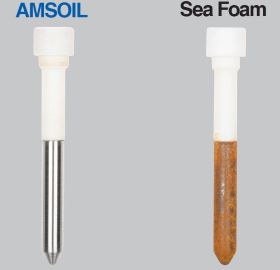Steps to Winterize Your Boat

Without a little TLC, long-term storage in any season can take its toll on your boat and motor. Here are seven steps to winterizing your marine equipment:
- Clean and inspect the boat and trailer – Taking the time to clean your boat can save you from wear and damage to key components. For the motor, inspect the spark plugs, wires and prop. Check the trailer springs and bearings and grease if needed. Perform any necessary repairs while the boat is out of the water.
- Change the motor oil – You can obviously skip this step for a two-stroke motor. Just ensure the reservoir is full.
In a four-stroke, change the oil and filter prior to storage so contaminants that have accumulated in the oil aren’t sitting in the engine all winter. Simply remove the drain plug and drain out the old oil. Remove the filter, too. Make sure to dispose of them properly. Wipe the filter mount clean and install a new filter, making sure to apply a thin coat of clean oil to the gasket. Reinstall the drain plug and top-off the engine.
- Stabilize the fuel – Gasoline can degrade in as little as 30 days. When the fuel degrades, it can lead to corrosion and deposits in your tank. Have the right amount of stabilizer in your gas tank and run the engine for several minutes to eliminate the need to drain the fuel system in order to keep it protected.
- Change the lower-unit oil – It’s critical to change gear lube prior to storage to remove any water so it doesn’t freeze, causing damage, or hasten rust on gears and bearings, shortening component life.
With the motor level, remove the oil drain plug and open the upper-level plug, which is usually on the side of the motor. While the oil is draining, look for any contaminants such as water or metal particles. For reduced mess and hassle, use the AMSOIL Synthetic Marine Gear Lube easy pack, which eliminates the need for a gear-lube pump. Refill the unit with fresh oil until it starts to come out of the top plug. Then, reinsert the top plug and then the lower plug. - Fogging oil – Fogging the engine applies a coating of oil to the cylinders, pistons, rings and other components in the upper end. This helps prevent rust formation during storage. In most cases, you need to run the motor while fogging it. But, some newer motors are equipped with automated systems that fog the motor for you. Check your owner’s manual for details about your specific motor.
- Grease the fittings – Locate any zerk fittings on the tilt and steering systems and fill with fresh grease as needed. Our Water Resistant Grease is perfect for all of your boat and truck’s applications!
- Store the battery – Be sure to charge and disconnect the battery. If your boat won’t be in a climate-controlled environment, it’s best practice to remove the battery and store it in your basement or other climate-controlled environment.
- Blow out any water – Water in the live wells, bilge or bilge pump should be blown out with compressed air so it doesn’t freeze. It’s a good idea to leave the drain plug out during storage. Once that is done, it’s time to cover and store the boat.
Check out this tech tip video to see how it’s done:








